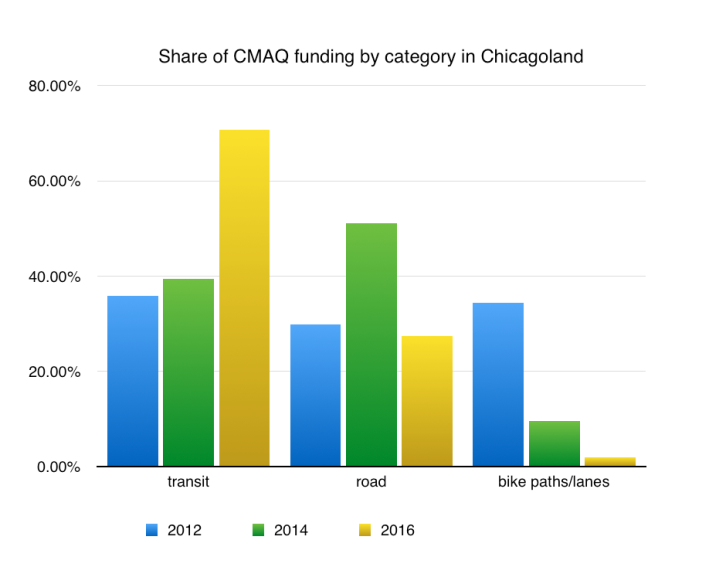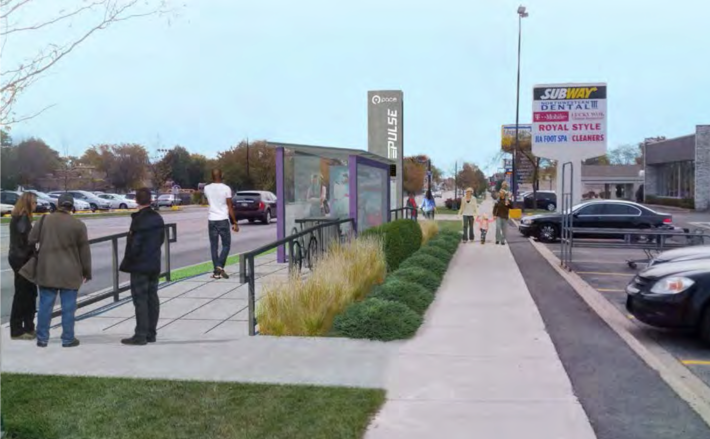Federal Funds Shifting To More Active Transportation Projects This Year
11:55 AM CDT on October 20, 2015

The next group of transportation projects that aim to improve air quality or reduce congestion and should receive federal funding has been approved by Chicagoland's regional planning organization. The Chicago Metropolitan Agency for Planning evaluates requests for the funding from the federal Congestion Mitigation and Air Quality Improvement program. CMAQ has ensured for nearly two decades that bike lanes are built and new Chicago Transit Authority and Pace buses go out on the road, among other active transportation projects.
CMAQ also funds widening roads and intersections, and linking traffic signals, on the premise that these reduce congestion, and thus reduce idling and unproductive emissions. The model that estimates these projects' impact on reducing CO2 and nitrous oxide emissions, though, should be called into question because it doesn't account for induced travel.
Induced travel, or induced demand, is the phenomenon when roads are modified to offer additional capacity, or have reduced congestion. This can briefly reduce travel times which then encourages motorists to use that road, make extra trips, or drive further – travel and trips they may not have otherwise taken in a car. This new capacity is quickly filled and the problem returns.
In this year's approved projects, however, the portion of funds devoted to road and driving projects has decreased from 2013 when I conducted my last analysis. When comparing the three categories of bike infrastructure, transit service and infrastructure, and roads, CMAP has devoted a smaller portion to road building in the next funding cycle than the previous two cycles.
I excluded some categories from the analysis, because they don't fit neatly into one of the above. These include projects that will purchase new vans for Pace's vanpool service, add lower and emission-free vehicles to public and private vehicle fleets, and replace freight and transit locomotive engines.
CMAP spokesperson Tom Garritano explained that "CMAQ projects...do not assume that more people will drive through an intersection as a result of it having been improved." He added that GO TO 2040 regional plan calls for doubling transit ridership by 2040, and said that CMAQ funding is part of "increasing commitment to public transit."
Indeed it is. Transit, compared to roads and bike infrastructure, is receiving a full 71 percent in the next funding cycle, a huge increase from previous funding cycles (although overall funding available has been diminishing).
A single transit project will receive 45 percent of the $274 million approved for projects to be implemented in the 2016-2020 funding period. CMAP approved the CTA to receive $125 million in federal funds that will combine with local funding and pay for the Brown Line bypass track between Belmont Avenue and Roscoe Street that will enable the CTA to run more Red Line trains.
However, not all transit projects have the same impact on offering good transit service and it might be inappropriate to use funding that can pay for big transit projects to have paid for these. Road and tollway budgets are a better source.
Pace, the suburban bus operator, got two of three of its transit expansion requests approved. First, Pace will run bus routes on the shoulder of Edens Expressway, during peak times. Pace will get $10 million in federal funds for the $14 million project to reconstruct the shoulders.
The second Pace transit project is to use $20 million in federal funds alongside $6 million in local funds to pay for bus operations and marketing for the routes that will use new lanes on a widened Jane Addams/I-90 tollway between the northwest suburbs and Chicago. It's questionable whether "transit" money should be used to fund what is essentially a road and personal driving project.
Running transit on a highway, including tollways, maximizes the capacity and built infrastructure – the concrete, rebar, and the cost of its construction and maintenance – of that highway by moving more people per lane than that highway would carry without transit.
Transit reduces congestion and improves the "customer experience" of the drive-alone motorist because fewer people are going to drive. Induced travel, however, can play a part here, supporting the idea that even more transit should be run – the more people not driving alone equates to faster commutes for everyone.
There wouldn't be a fracture in the toll collector-toll payer relationship to use some toll revenue to pay for a convenient bus service if it meant that "other people" will avoid driving on the highway and take the bus instead. Buses wouldn't pay tolls because their contribution to the tollway is making it so there are fewer fellow motorists to compete with.
And while buses on highways are faster than buses that don't run on highways, running buses on highway isn't the best case scenario for transit. When the buses get off the highway is there a bus lane between the off-ramp and their downtown destinations, and was it possible to use transit, walking, or bicycling to get to the suburban start of the trip?

This use of transit funding isn't as bad as finding out that the third Pace project wasn't funded. Their "Pace Pulse" arterial rapid transit line on Dempster Ave. – between the Davis St. Purple Line station in in Evanston and O'Hare airport – would put good transit service in a contentious surface road environment within cities, where transit can actually compete with driving and win mode share.
Pace asked for $19 million to buy new buses, install traffic signals to give buses priority, and permanent shelters with bus tracker displays. It was rejected because the CMAP transportation committee wanted to see that Pace first gained experience from implementing and operating their Milwaukee Ave. Pulse route.
Pace Pulse represents the "all kinds of trips" transit, for commuting, or for trips within and between neighborhoods, while expressway buses are commuter-oriented and use park-and-ride lots where suburban residents commuting to downtown still have to drive their cars to reach the bus.
I want to leave you with one more project that CMAQ is funding. The Aurora Transportation Center enhancements, funded by CMAQ at 58 percent of the project cost, will build 789 new car parking spaces in downtown Aurora, Illinois – plus a new bike and pedestrian bridge over the river [PDF]. It's another example of a "faux transit" project. The project is an example of our continual funding of road projects over transit projects, perpetuating the delay in shifting to a planning paradigm that regularly includes transit in the development of suburbs.
The CMAQ funding program has been essential to building needed bicycle and transit infrastructure, and the CMAP committees and board must continue to reducing the share of road and driving projects while working with municipalities to design good projects.
Stay in touch
Sign up for our free newsletter
More from Streetsblog Chicago
Today’s Headlines for Thursday, April 26
The de-facto ban on riverwalk biking is back. What should we do about it?
In the short term, new signage is needed to designate legal areas for cycling on the path. In the long term CDOT should build the proposed Wacker Drive protected bike lane.


